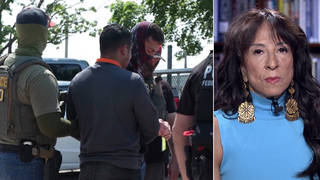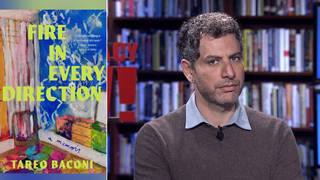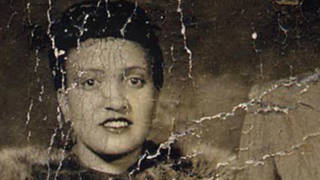
Topics
Guests
- Susan Reverbyprofessor of women’s and gender studies at Wellesley College in Massachusetts. Her article on the Guatemala study will be published in the January edition of Journal of Policy History. She is also an expert on the Tuskegee experiments and author of the book Examining Tuskegee: The Infamous Syphilis Study and its Legacy.
Recently unearthed documents show around 700 Guatemalan soldiers, prisoners, prostitutes and mental patients were infected as part of a study into the effects of penicillin. It’s unclear if the patients were ever cured of the diseases or even given treatment. Hours after the findings were revealed, President Obama apologized to Guatemalan President Álvaro Colom, who called the experiments a “crime against humanity.” We speak to Susan Reverby, the medical historian who discovered the Guatemala study. [includes rush transcript]
Transcript
AMY GOODMAN: The United States has apologized to Guatemala over the disclosure government researchers deliberately infected nearly 700 unknowing Guatemalans with syphilis and gonorrhea in experiments during the '40s. Recently unearthed documents show about 700 Guatemalan soldiers, prisoners, prostitutes, mental patients were infected as part of a study into the effects of penicillin. It's unclear if the patients were ever cured of the diseases or even given treatment.
On Friday, State Department spokesperson P.J. Crowley said the Obama administration has apologized.
P.J. CROWLEY: Yesterday afternoon, Secretary Clinton called President Colom of Colombia [Guatemala] to express both her shock at the discovery of the details of this research and also to apologize on behalf of the American people. During the course of the conversation, she also invited Guatemala to participate fully in the investigation that we will carry out to determine the facts behind this research.
AMY GOODMAN: Hours after the findings were revealed, President Obama personally telephoned Guatemalan President Álvaro Colom to apologize. Colom called the experiments a “crime against humanity.”
PRESIDENT ÁLVARO COLOM: [translated] It’s an incredible violation of human rights. But there it is. We must face it. We’re going to do whatever is necessary so that we can find out quickly the effect on people, because what we’re interested in is the victims. Obviously indignant. And if there were officials from the past who were involved in this, that also needs to be told.
AMY GOODMAN: Guatemalan President Colom also says his government is studying whether it can bring the case to an international court.
The Guatemala study is the latest covert US government human experiment to come to light. The head of the study, Dr. John Cutler, was also involved in what many consider the most infamous case, the Tuskegee experiments. For forty years, US government researchers deliberately withheld medical treatment from over 600 African American men who had syphilis, despite misleading them to believe they were receiving care.
Well, today we’re joined for the hour by the medical historian who discovered the Guatemalan study, Susan Reverby. She’s a professor of women’s and gender studies at Wellesley College in Massachusetts. Her article on the Guatemala study will be published in the January edition of Journal of [Policy] History. Susan Reverby is also an expert on the Tuskegee experiments and the author of the book Examining Tuskegee: The Infamous Syphilis Study and its Legacy. Susan Reverby joins us now from Boston.
Professor Reverby, thank you so much for joining us.
SUSAN REVERBY: Thank you very much for asking me.
AMY GOODMAN: Well, we have a lot to talk about today, but why don’t we start by you telling us how you discovered this story of what happened in Guatemala in the 1940s?
SUSAN REVERBY: I discovered this history in the way that historians do their work. That is, we go to archives, and we read, as a friend of mine put it, dead people’s mail. And I was in the University of Pittsburgh Archives doing research for my Tuskegee book, looking into the papers of Thomas Parran, who was the surgeon general in the '30s and ’40s, who was primarily concerned with syphilis. And I realized that John Cutler, who had also been very important in the Tuskegee study, had taught at Pittsburgh and had left papers there, so I asked to look at whatever he had left behind in the archive.
I opened the boxes expecting to see material about Tuskegee, and all that was in the boxes were his unpublished field notes, his lab reports and lists of patients and pictures of what had happened in Guatemala. And you can imagine my unbelievable shock on finding this. I just had no idea it was there, and neither did anybody else, because none of this had ever been published.
AMY GOODMAN: Now, this is very significant. You've written two books on Tuskegee, and there have been many other books written, as well, not to mention research. So to see the word “Guatemala” in these papers, what did you first think?
SUSAN REVERBY: Well, the words that hit me before I saw “Guatemala” were “inoculation syphilis.” And I’ve spent now almost two decades working on the Tuskegee study, and one of the things I do is spend a lot of time trying to explain to people that the United States government did not infect anybody in Tuskegee, that the man already had late latent syphilis. So, seeing the word “inoculation syphilis” was pretty shocking. And then realizing that this research, which wasn’t done in Tuskegee, had been done in the Global South rather than in the American South was just unbelievable, as I increasingly read the details of this and was pretty, as you can imagine, horrified by what had happened.
Though one of the things I want to correct in your lede in, this was really a study to look at treatment, so it was very different than Tuskegee. They were creating infection, but they were also interested in whether penicillin could be used as a prophylaxis. So, the way to think about this is, if you think about the morning-after pill, if you take the morning-after pill, it’s because you’ve had unprotected sex and you think you might get pregnant. The idea here was that if soldiers or other men, in particular, had had unprotected sex, they could possibly use penicillin as a kind of — in a lotion form, rather than wait 'til they had the infection. So that's what they were trying to study. It wasn’t, in that sense, unreasonable. What was of course unreasonable was not asking, creating infection, violating all these kinds of things that we now think were horrific, but at the time they were real issues about whether or not this was — there was no illegality, in a general sense.
AMY GOODMAN: I would guess that people in the 1940s would be absolutely appalled if they heard. You’re talking about treatment for perhaps soldiers here in this country, so they go down to Guatemala and they inject people unknowingly with syphilis. Explain how exactly they did this.
SUSAN REVERBY: OK, let me explain why, first of all, they went to Guatemala. They went to Guatemala because prostitution was legal in Guatemala, and it was legal to bring a prostitute in for sexual services into the prisons. So Cutler was partnered with a man named Juan Funes, who was the director of sexually transmitted diseases, or what was then called venereal diseases, in the Public Health Department in Guatemala. He had also been trained in the United States by the Public Health Service. So it’s Cutler and Funes and a few other doctors who go down. And the initial studies were using the prostitutes and then giving the treatment if people developed the disease. When they couldn’t create enough infection by allowing the prostitutes in, that’s when they started to do inoculations.
And the way the inoculations worked was they — first of all, let me explain. Syphilis is not an easy — there’s a reason it’s a sexually transmitted disease. You can’t just draw blood from someone who has syphilis and give it to somebody else. You actually have to create an inoculum. The disease — the bacteria that causes the disease can die when it’s in the air, which is why it has to pass through liquids and body fluids, primarily. And that’s why it’s sexually transmitted. So they created an inoculum using the ground-up testes of rabbits that already had the disease, and then they abraded or scraped the arms of people in the prison and in an insane asylum and in an army barracks. They used their arms. They used their cheeks. They also looked for men, frankly — I mean, this is the really, to me, absolutely unbelievable part that makes it look like a B-movie — they found men who had long foreskins. They took their penises. They moved the foreskin back. They abraded the head of the penis. They made the inoculum and put it on a little cotton — what’s called a pledget, or piece of cotton gauze. They held the penis for an hour and a half or two hours and hoped that they could transfer the infection this way.
AMY GOODMAN: What were they telling the men that they were doing, these US government doctors?
SUSAN REVERBY: You know, it’s impossible to know. They didn’t say in the records. I mean, all I have is, you know, Cutler’s notes back and forth, so I’m sure they made some kind of explanation. Cutler spoke Spanish, which is one of the reasons they sent him. Not every prisoner, of course, went along with this. And Cutler, at one point, is complaining because one guy, you know, got up and ran away with the piece of cotton still attached to his penis. There were people who refused to do it. Many of the prisoners thought that all the blood draws that had to happen would weaken them, and they refused to do it, even though they were being given iron pills, as well, to take care of it. I mean, remember, this is being done in the context of this kind of experimentation — I mean, not this particular kind — going on elsewhere in the country, where people who were institutionalized, whether they were prisoners or in hospitals, were considered the people you used to do this kind of experimentation.
AMY GOODMAN: And in addition to doing what you just described to these men, there were other ways they tried to infect them with syphilis when they weren’t able to get enough people infected.
SUSAN REVERBY: Right, other than the — yes, they were doing the abrading. They used — at one point, they did some spinal taps, as well, to get — to try to get the inoculum in. And I think the important thing to think about here, too, is, you know, we —- it’s too easy to say, OK, this was a period when there wasn’t research norms or any of the kind of regulations we’ve had in place since the mid—'70s. But Cutler's bosses at the Public Health Service knew this was sort of really on the edge. And the quote that I found that just really knocked me off the chair was one from the surgeon general himself, who said — and this is secondhand, but it was in a letter to Cutler where one of his colleagues said, “The surgeon general says, 'Well, we couldn't do this in the United States.’” And that’s just a stunning, absolutely stunning, acknowledgment of what was going on.
AMY GOODMAN: We’re going to go to break, but when we come back, upon this discovery, in your writing up of your study, I want to talk about how this has now become public. We’re talking to medical historian Susan Reverby. She is a professor at Wellesley College. She’s written two books on Tuskegee, the latest, Examining Tuskegee: The Infamous Syphilis Study and its Legacy. And we’re going to talk about the Tuskegee experiments, as well as many that have been done around this country over the decades with unwitting, unknowing, unwilling subjects.
This is Democracy Now! Back in a minute.
[break]
AMY GOODMAN: We’re spending the hour on medical experimentation, the latest explosive story about a study that was done about a half a century ago, in 1946, '48, American public health doctors deliberately infecting nearly 700 Guatemalans with syphilis and gonorrhea. Susan Reverby is the professor, the medical historian, who discovered this story, and Susan Reverby joins us now. She teaches at Wellesley College.
Professor Reverby, you made the discovery, and then you actually did a presentation of this at a conference, but there was very little outcry or response.
SUSAN REVERBY: Well, the best way to explain this is, I wrote it up — I finished the research, I wrote it up, I gave it as a paper at the History of Medicine meetings in Rochester, Minnesota, last May, but I was on the last day of the last session on a Sunday during the semester, so there were maybe twenty people in the audience. And, you know, my colleagues were pretty horrified, but, you know, historians are — I don't mean to say we’re jaded, but people understand that this has happened in the past. We all knew about other kinds of studies. So we had a lively, I’d say, conversation, but, you know, historians don’t, like, run out of the room screaming and call the National Enquirer. It’s sort of not what we do. And I — and people asked me what I was going to do with it, and I said I had been asked to write this up for the Journal of Policy History. And they were doing a special issue on human subjects. So I, you know, finished the semester, I wrote the paper up, and I sent it off to the journal. It’s going to be published this January in their special issue.
But what I also did with this — and I think here is where the difference is between what historians normally do and what I did and was lucky enough to do, frankly, in this situation — while I was working on the Tuskegee book, I had interviewed and then, you know, kept up my relationship with a man named David Sencer. David Sencer is a physician, now retired — he’s in his eighties — and he had been the director of the Centers for Disease Control in the late '60s and ’70s, when the story of Tuskegee had broken. And so, I had interviewed him. We had talked about it. We had talked a lot about research and government research. And also, you know, I was writing a paper about syphilis. I'm not a physician. I’m a medical historian. And I sent it to him and said, “Please look at this, make sure the medicine is correct, and tell me what you think. And I wanted you to know about this.”
So he read it, and he was completely horrified. And he wrote me back immediately, so this might have been late June, early July now. And he said, “Do you mind if I send this to people at CDC so that they know that this is coming?” And I said yes, because, you know, it wasn’t like I was discovering the cure for cancer and didn’t want to share it with anyone 'til I got to publication. It was important to let them know and for them to think about it.
And they read it. They gave it to their leading syphilis expert. They asked me for more material. I sent them my notes, frankly, and then they said, “We need to look at this, too.” And so, they went up to Pittsburgh to look at the archives. And when their lead syphilis expert wrote his report up, it corroborated what I had said, so it was like getting the best peer review you can imagine. And then they started to talk about it within CDC, and then it went up the chain of command, I understand, from CDC to the National Institutes of Health, and from there, you know, because it was international, to the State Department and then eventually to the White House. So all of that working that through took about a month, a month and a half, frankly, so I think Douglas's report, the man who went to Pittsburgh, came out in early August, and so it took them a couple weeks to figure out, you know, how to respond to it. And that’s what happened. But we should really thank Dr. David Sencer for giving it to CDC. I mean, he had the connections, obviously; I did not.
AMY GOODMAN: We’re talking with Professor Susan Reverby. She’s a medical historian. She’s exposed this latest study done in the '40s in Guatemala. So, spinal taps, direct injections of syphilis, gonorrhea. This is now — President Obama called the Guatemalan president. The Guatemalan president Álvaro Colom has called this a “crime against humanity.” He wants an international investigation. What do you think of his response, Professor Reverby?
SUSAN REVERBY: Which — Colom's response?
AMY GOODMAN: Yes.
SUSAN REVERBY: Or Obama’s response?
AMY GOODMAN: Yes, Colom’s response.
SUSAN REVERBY: Colom’s response. I think he’s right. I mean, I think this was horrific. I mean, but we’re going to have to understand why it was done and remember that there was an attempt to treat, so that — I mean, I’m not trying to downplay — please understand this — anything that went on here, but it was a treatment — in the end, it was supposed to be a treatment study. What we’re going to have to look at is the data to try to figure out in each of these cases whether enough penicillin was given to everybody —-
AMY GOODMAN: How many people died?
SUSAN REVERBY: —- to cure them. When you think —-
AMY GOODMAN: Is it -— is it known in Guatemala how many people died?
SUSAN REVERBY: We don’t — we don’t know. We don’t know. We really don’t know. One person, for sure, we know died from epilepsy during it. Syphilis does not cause epilepsy. Many of the people who were in the state insane asylum already had epilepsy. That’s in fact why they were in this asylum, which is really horrific. And one of the things the Public Health Service did was to give Dilantin, which is the drug of choice at that time to cure epilepsy, to the institution as part of the quid pro quo for getting in.
So, I think Colom is right that this was horrific and should be looked into. And frankly, I hope that they can find anyone still — you know, the children or anyone from it alive, because these were contagious diseases for the people who weren’t totally cured. And looking at the medical records of all these people, the guesstimate at this point from the CDC physician is maybe about a third of these people weren’t given totally the right amount of treatment. But we’ll have to look into it. We don’t know, for example, whether Juan Funes, within the Guatemalan Public Health Service, then followed people up and gave them the right treatment. None of us know that. And I was only working with what Cutler had left behind. I had looked for more material in the National Archives, which is where all the Public Health Service material is left, and I didn’t see anything else. So all we have, because this was unpublished, is what Cutler left behind in these records.











Media Options